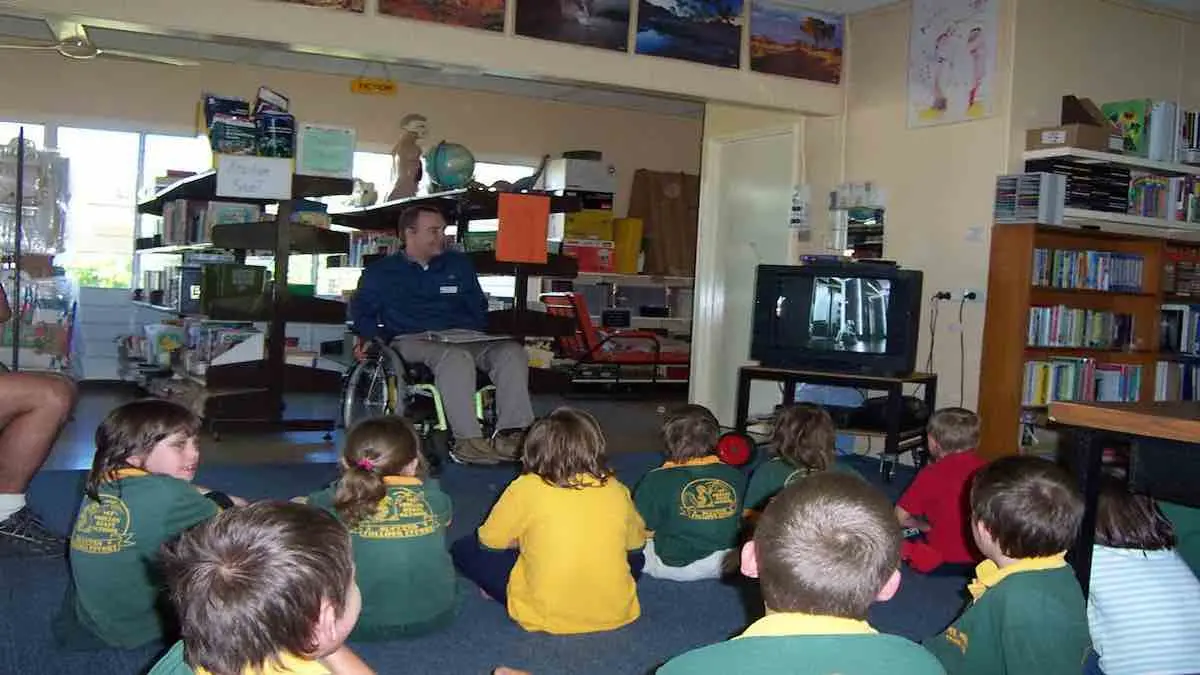“Concentrate on the abilities your disability doesn’t hinder and don’t dwell on the things it interferes with. Be disabled physically, not in spirit”
– Stephen Hawking
Table of contents
- Disability
- Challenges faced by people with disabilities
- Support for Disabled
- Disability issues in Australia
- Southside and People With Disabilities Job Revisited
- Work for People with Disabilities
Disability
People with disabilities leaving the PA Hospital Spinal Unit must transition back into the community. My family had always lived on the south side of Cairns. When on occasion I had travelled away, I usually became depressed after a week or two. Becoming severely disabled and being stuck in Brisbane for 9 months was almost unbearable. I could not wait to get home.
Our new house in the suburb of Bentley Park was finished by the summer of 1992. We moved in immediately. Around the same time I was accepted to study at James Cook University (JCU). As the first quadriplegic to be enrolled at their Cairns Campus, I looked forward to the challenge.

Challenges faced by people with disabilities
For Jenny and I, the first two years following our return to Cairns were the hardest of our marriage. Fights were commonplace. The reasons normally sprang from frustration on my part.
I would drop something, or want something I could not reach, and “JENNY” I would yell, normally followed by an expletive. Any delay would lead to impatience and anger on my part. Further delays often led to uncontrollable rage. This frequently resulted in broken glass or anything else I could reach, as I pushed items to the floor with my paralysed hands.
Support for Disabled
We solved my biggest ‘adjustment’ issue by gaining access to a Centacare program that provided support workers who could act as my hands. Consequently, this gave me an understanding of how support work is crucial to enabling people with severe disabilities to lead fulfilling lives.
During my time in Princess Alexandra Hospital, and on my return home, I had little reason for optimism about my future. People held limited expectations of me, and I saw few role models with disabilities in Far North Queensland – certainly none who had gone on to live the sort of life that I had dreamed of before my accident. However, the time Jenny and I spent in our new home saw us make important decisions that would give us a sense of direction and purpose.
Books of Influence
Some books can change your life. During 1993, I had more free time to read than ever before. History and political biographies were some of my favourites, but I also enjoyed novels by Dickens, Chekov, and George Orwell. However, the book that influenced me the most was The Grapes of Wrath, by John Steinbeck.
Set in the United States during the Great Depression, “The Grapes of Wrath” examines the hardships confronting the Joad family. The Joad family lost their farm and home to the bank, and decided to set out west to California for a better life.
On their way they confronted a ragged man from their hometown, who had tried life in California and was returning home to die. Devastated by his experience of suffering and starvation in California, he said to Tom Joad:
“Somethin it took me a year to find out. Took two kids dead, took my wife dead to show me. But I can’t tell you. I should of knew that. Nobody couldn’t tell me, neither. I can’t tell ya about them little fellas layin’ in the tent with their bellies puffed out an’ jus’ skin on their bones, an’ shiverin’ an’ whinin’ like pups, an’ me runnin’ aroun’ tryin’ to get work—not for money, not for wages!”
The Promise of Tom Joad
Shaken by the ragged man’s comments, as his own hungry family continued towards California, Tom Joad turned to his friend, Preacher Casey. He asked, “Is that guy telling the truth?” Casey replied, “The truth for him maybe, the truth for us, we’ll see!”
The Grapes of Wrath ends with Tom Joad convinced of the need to fight for ‘the people’. When forced to leave his family in this fight for justice, Tom says farewell to his mother thus:
“I’ll be all around in the dark – I’ll be everywhere. Wherever you can look – wherever there’s a fight, so hungry people can eat, I’ll be there. Wherever there’s a cop beatin’ up a guy, I’ll be there. I’ll be there in the way guys yell when they’re mad. I’ll be there in the way kids laugh when they’re hungry and they know supper’s ready. And when people are eatin’ the stuff they raise and livin’ in the houses they built – I’ll be there, too.”
Joad’s lines were thus delivered by Henry Fonda in the movie adaptation:
A Fresh State of Mind
This book made me realise there is no point in worrying about the future or judging your own life by the experiences of others. I knew Spinal Cord Injury had ruined many people’s lives, but would that be the truth for me? I decided to have a go at life and, together with Jenny, see what the truth would be for us.
However, deciding exactly what I wanted to do had been my main dilemma since my return from the spinal unit. I had so many different ideas, but so few were practical or possible. Finally I decided I would further my education and throw myself into fighting for the disadvantaged. I wanted to campaign for social justice, to be a Champion of the Underdog.
University Firms as Future
Unfortunately, the University was about to relocate to Smithfield, north of the city. It would be too far for me to travel there often, so what would I do? After much thought, Jenny and I decided we would move to Kewarra Beach.
We sold our home in Bentley Park and started building a new house at Kewarra Beach. It was a difficult financial decision, but in every other way, the move opened up a world of opportunities. Our house was finished a few weeks before the opening of the new University Campus. A fresh start at last!
Disability issues in Australia
It was apparent to me that the only reason I could live independently in the community was because I had Jenny caring for me. I asked myself, “What about other people with disabilities?”
I was shocked to learn that many people with disabilities were living in institutions, including a high number of young people with disabilities living in aged care. A major goal of the disability movement at this time was to have all people with disabilities living in the community, rather than isolated in institutions.
I could see things were not right! Consequently, I became passionate about people with disabilities being included in the community. I was also frustrated with so many of us being denied access to shops, businesses, and some public services, by simply not being able to get in. This was not good enough!
People with Disabilities Advocacy
During the 1990’s I became a passionate advocate for people with disabilities. I was determined to address the injustice and discrimination I saw everywhere. It was a core value of mine that people with disabilities should experience the same or a similar quality of life to that enjoyed by other members of the community. People with disabilities have the same human rights as other people.
The very concept of community must have ‘diversity’ at its heart. Healthy communities include young people and old people, white people and black people, gay people and straight people. Above all, I was sure a community should include people with disabilities! Consequently, I volunteered to serve on a number of organisations committed to fighting for inclusion.
I served as the Queensland Network Officer of the Australian Quadriplegic Association (AQA) for several years. I reported on disability related issues and concerns in Queensland. This position with AQA involved lobbying Government to improve funding and the quality of service provision. I certainly grew the organisation in Far North Queensland and gained recognition from the AQA Board. In 1998 I was elected as a Director of AQA, becoming the first person outside of NSW to sit on the Board. AQA later became Spinal Cord Injuries Australia (SCIA).
Transport Access for People With Disabilities
Transport is crucial to the lives of people with a disability. There is no point in having an inclusive community if you find yourself a prisoner in your own home. During the 1990’s, many people with disabilities had contacted the local bus service, Sunbus, requesting wheelchair access. Not one bus in Cairns provided access.
Gail Harris and I contacted the Cairns Community Legal Centre (CCLC). We took an anti-discrimination action against the owner of Sunbus, Transit Australia. At CCLC we secured the assistance of a lawyer and disability advocacy champion, Julie Fry. Julie agreed to act for Gail and I against Sunbus.
With Julie’s help, Gail and I took this matter all the way to a hearing. While we lost the case, as a result of our actions and those of other people with disabilities across Australia, new accessible transport standards were adopted. Today in Cairns, every bus has wheelchair access!

Accomodation Support
Prior to 1997, all accommodation support in Cairns for people with a disability had been administered either by church-run organisations or the Endeavour Foundation. A quadriplegic friend, Gail Harris and I decided we wanted a local grass-roots provider that gave us a say in service provision. We adopted the mantra ‘nothing about us without us’.
Following extensive discussions with the Department of Families, Youth and Community Care, service providers, and consumers, Far North Queensland Independent Living Support Association (FNQILSA) was formed. We recruited the lawyer from our transport case, Julie Fry, to be the Manager of our new service.
FNQILSA was officially launched on 8 July 1997 to provide accommodation support for people with disabilities. Importantly, it had a Management Committee comprised of several people with disabilities, their carers, and family members.
FNQILSA was an exciting initiative in creating a consumer-driven organisation that gave people with disabilities more control over their lives. I was honoured to serve FNQILSA as a Committee Member and President.
Other friends and activists for people with disabilities
Through my friendship with local woman and disability advocate Lyn Coyle, I became involved with the Cairns based advocacy organisation Outright Independence.
As a member of ‘Outright’ and Queensland Advocacy Incorporated, I developed a better understanding of the needs of people with intellectual disabilities. Proper advocacy was so important to enable these people to chart their own destiny.
When a lack of funding caused Outright to close, many of us got together to ensure people with disabilities had an advocacy organisation here in Cairns. This was the genesis of the body known as ‘Rights in Action’ (RIA).
For two years, I also served on the Physical Disability Council of Queensland, and was a representative on the Physical Disability Council of Australia. These two peak bodies were responsible for advancing policy issues for people with physical disabilities.
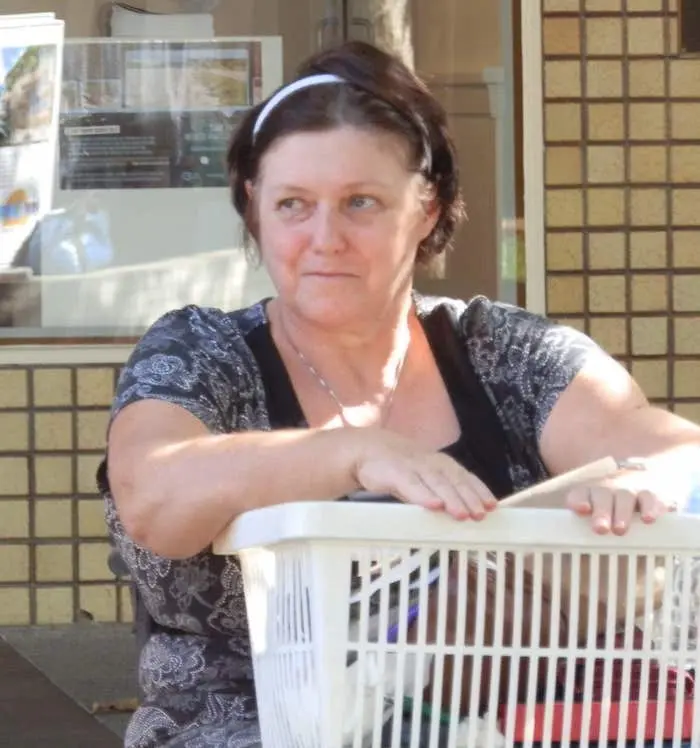
FNQ Regional Disability Council
In 2004 I was appointed as the Chair of the FNQ Regional Disability Council, making me also a member of the Disability Council of Queensland (DCQ). Appointed by then Minister Warren Pitt, I met many great friends during my time on our local disability council, including Suzy O’Reilly and Doug Robbins. I also worked with Elsie Butler (the wife of Bill Butler, my old work colleague from the Public Trustee). They were both great advocates as well as parents of a child with Down Syndrome.
Many of the activists I worked with in the struggle for the rights of people with disabilities had exceptional qualities. These virtues resulted from their difference and the richness of their life experience. This included overcoming the many barriers people with disabilities face on a daily basis.
Members of the Council were George Theobold, Pat Hereghty, Doreen Mortimore, Suzy O’Reilly (now Jackson), John O’Brien, Elsie Butler and Doug Robins, ably assisted by Executive Assistant Kylie Bock. I fondly remember our term of service. A time spent listening to our community and feeding their concerns to government.
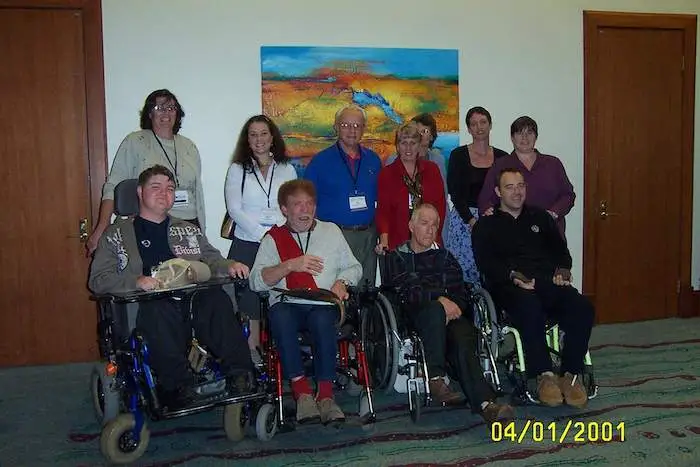
Doug and Suzy
Doug Robbins was born with the Duchenne Muscular Dystrophy gene. Over his childhood years, his parents watched him decline from an able-bodied toddler to a wheelchair using teenager. They realised he would not live to be an old man. Doug was a school captain at Smithfield and was much loved by his fellow students.
After completing his school education, Doug embraced the arts. He became the creative mind behind numerous theatrical presentations. The arts proved a wonderful opportunity for Doug to express his talent and creativity.
Suzy O’Reilly (now Suzy Jackson) became another good friend. Suzy and her sister Karen were the children of deaf adults. Their mother Carol O’Reilly authored the book Australian Deaf Story. Suzy went on to complete a psychology degree at JCU, and has been a powerful advocate for social justice.
James Cook University in Cairns
For me, as for many others, the opening of James Cook University Cairns Campus in 1996 represented a great opportunity. I hoped that a degree would expand my employment opportunities.
I had long been interested in politics and public policy, and in their capacity to make the world a better place. In the words of Nelson Mandela, “Education is the most powerful weapon which you can use to change the world.”
Enjoying our new home
Our new home in Kewarra Beach was much more suited to the needs of a wheelchair user. Located in a flat sub-division off Poolwood Road, it allowed me to get outside (even with just 50 per-cent arm function) and push down nearby streets.
My daily outings with our dog Tia were a joy, as we investigated our new surroundings. At first, I could barely get 50 metres before my arms would wear out. After a while, I could make it 200 metres, and was looking for newer streets to challenge myself. These outings became a regular part of my life. I enjoyed getting out of the house and venturing down the street.
Intellectual Growth – History and Politics
University was more stimulating in the new environment as well. For the first time, JCU had a dedicated campus in Cairns. My studies focused on history and industrial relations. I found both subjects stimulating and engaged in wide reading on them.
Dr. Dawn May and Dr. Doug Hunt were my lecturers. They were lovely people who always had their doors open to students. Dawn was very down to earth for an academic. Both Dawn and Doug became personal friends who Jenny and I always held in high regard. Their supportive attitude was crucial for me and countless other new students.
I developed a detailed knowledge of labour history and the evolution of the trade union movement, from the 1890’s right through to the infamous 1950s ALP split. Studying the humanities became my passion.
The History of the Oppressed
I started learning history from new perspectives. It was immediately evident to me that the history I had previously known was written by ‘winners’ – those in positions of power who were able to have their voices heard.
For the first time, I was learning a different history – a history from the perspective of women and from the perspective of our first people. It was during this time that I became a passionate advocate for the rights of Indigenous Australians.
I learnt the stories of great Aboriginal warriors who bravely defended their homelands before losing their lives, such as Pemulwuy and Jandamarra, two of the most notable leaders to resist the white invaders. I was shocked to learn that more Aboriginal people had died in defence of Tasmania than the total number of Australians killed in the Gallipoli campaign.
Progressive historians such as Henry Reynolds offered new insights into Australian history. I also became a great fan of one of the greatest minds the world of broadcasting has produced, Phillip Adams, with whom I struck up a correspondence.
Adams’ articles and his programme Late Night Live on Radio National provided me with inspiration and an intellectual alternative to the hegemony of the mass media, with its ‘infotainment masquerading as current affairs’ and its moronic American sitcoms.
Cairns Campus Student Association & Union Life
Hollywood Hills
The President of the Student Association in 1995 was a woman with the theatrical name of Michelle Hollywood. Michelle was in the now defunct Socialist Left faction of the ALP. During her time as President, Michelle campaigned to protect the hill-slopes around the university from development.
This campaign attracted strong community support, and we all lobbied Cairns Regional Council. This was not hard for me to do, because Tom Pyne was the Mayor. At regular family gatherings I would lobby dad on this issue.
It was great news when we heard our campaign had been successful, with Council determining that the land would not be developed! We had saved the natural surrounds. James Cook University would later become known for its excellence in tropical environmental studies.
President Rob
Towards the end of the year, I was approached by Michelle to run for President of the Student Association. I decided to throw my hat in the ring and I argued for my vision for student services.
I placed my nomination on the notice board as soon as they opened. When nominations closed, mine was the only one received. I was elected unopposed!
For the first time since my accident, I had a full-time position, President of the Cairns Campus Student Association. This would take a year out of my life, but also provide me with opportunities that I had not experienced.
When I took over the President’s office, there was a string of photographs at the bottom of the noticeboard, showing all the hills surrounding the campus. I made sure I left them there and put the words ‘Hollywood Hills’ above them. I did this to provide a reminder that when we are fighting for the people against those in power, every now and then, just once in a while, we have a win!
Austerity under the LNP Howard Government
During the year that I was President, I faced many challenges. It was a difficult time for students, with the ultra-conservative Howard Government’s attacks on higher education.
Education Minister Amanda Vanstone announced Government plans which included the introduction of full fee-paying requirements for undergraduate degrees. The Student Association responded with several campaigns during the year, including rallies, sausage sizzles and media events.
In June I went to Perth as a James Cook University representative at the National Education Conference. I was also a delegate of our Labor Club to the National Organisation of Labor Students (NOLS) meeting. I was impressed by the professionalism of the campaigns run by the larger Student Unions and the National Union of Students against the Howard Government’s changes to higher education.
Unions and The ALP
As President of the Student Association, I reached out to the wider trade union movement and formed valuable alliances. During the year I met a woman named Pat Nicholls, who was the local organiser for the Nurses Union and President of the Cairns Council of Unions.
Pat had the job of organising Labour Day and she was keen to have me involved and have a speaking role. Sadly, Pat had diabetes and needed to have her leg removed as a consequence. So we were united in having a disability as well. Unfortunately, diabetes would result in Pat dying far too young.
At this time there was a new left faction forming in the ALP. It looked interesting to some of us at the university, so I re-joined the party, becoming a member of the Northern Beaches Branch of the ALP.
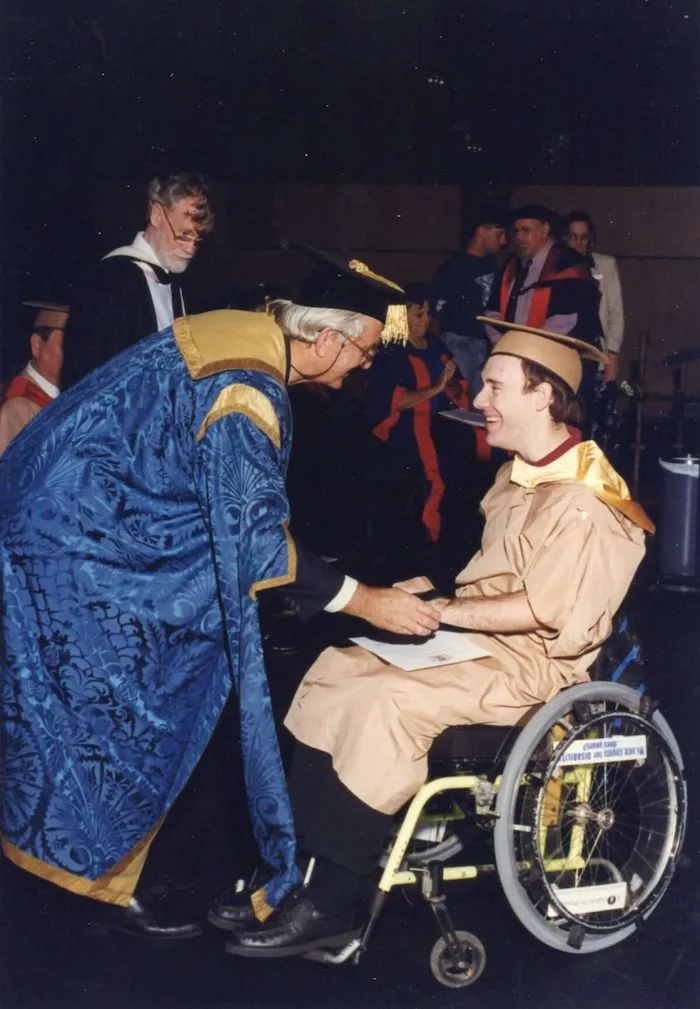
Law and a Job Opportunity
After a year my term as President of the Students Association concluded. By this time, I had graduated from my Bachelor of Arts degree. While I was happy with my B.A., I was conscious that it might not give me the ‘equalising factor’ I needed to access employment. The truth is, when the choice is between an able-bodied person or a quadriplegic, the able-bodied person will usually get the job.
I felt I would continue to miss out, unless I could point to something that gave me an edge over the competition. With this in mind, I enrolled to study law (externally) through QUT.
It seemed to me that a law degree had replaced what an arts degree used to be, as a multi-disciplinary degree that offered the requisite skills I needed to access mainstream employment opportunities.
Studying law involved massive amounts of reading. Fortunately, some subjects were fascinating, and made time fly by, even though others were a chore to complete.
Disability and Des Butler
The truth is, having a disability like quadriplegia makes everything harder. I have not been afraid of asking for special consideration to level the playing field or create a bit of equity. This was the case in the early 2000s, when I was battling my way through law and had to visit Brisbane for an assessment on contract law.
I had asked for extra time and assistance to complete my contract law assessment. I was confident that upon my arrival, any lecturer would note my obvious disability and grant extra-time (on the basis of the fact I was in a wheelchair and no longer had use of my hands).
Imagine my surprise when I arrived at QUT to find the lecturer was also a quadriplegic! His name was Des Butler. This was a remarkable coincidence, and while I was almost afraid to ask, I was indeed granted extra-time and a notetaker.
Des Butler was a man of great intellect and a razor-sharp mind, who despite his disability, contributed greatly to the law faculty at QUT. As a person with the same disability I knew just what Des had overcome and how great his achievements were.
I went on to complete my law degree. While I was happy with my results, I did not believe I would excel as a legal practitioner, partly due to the practical difficulty of having someone take me on to complete my articles, given my lack of mobility and hand function.
Job Opportunity
In July 1997 an advertisement appeared for a Regional Disability Liaison Officer (RDLO) for the higher education sector. Upon reviewing the selection criteria, I felt confident that I could prepare one hell of an application for the position. My wealth of experience with disability groups, my year as President of a student union and my B.A. were bound to give me a good shot at the job, worth $40,000 a year (quite a good salary for the time).
I sent my resume off with high hopes. A friend of mine, Louise Yates, a paraplegic living in Townsville, had also applied for the position. Louise was quite talented. During the early 80s, she played a role in a highly successful Australian television drama, Cop Shop. Some may remember her as “Sarge’s daughter”. Louise and I were both granted interviews for the position, which was advertised in Townsville as well as Cairns.
Joy and Disappointment
On my way to the interview at James Cook University, I was more nervous than I had been in years. I was wearing a long sleeve shirt for the first time in ages. The interview was held by teleconference. As an experienced public speaker, I knew when I had performed well and when I had not. In this case, I felt sure I had blitzed the opposition!
Jenny arrived early and heard the last part of the interview. The head of the selection panel thanked me for putting forward my case in such an “articulate and intelligent manner”. As Jenny and I left the building for lunch, I could not have felt more in control of life.
When I heard that I had missed out on the job, it was quite a blow. I rang Louise, who told me she had also been rejected. The successful applicant was an able-bodied woman from Townsville, who I was informed had more experience working with people with disabilities. I could not contain my anger, thinking of how many hours I had given on a voluntary basis to serve other people with disabilities. I felt none of this work had been recognized.
Jenny and IVF and My Addiction
Jenny had carried a heavy workload during our time at Kewarra Beach. She successfully applied for a job at the Redlynch Day Care Centre, where she looked after babies and toddlers. Caring for me, while also working, was an amazing achievement! To add more stress to Jenny’s life, it was at this time that we decided to enter the IVF program. Jenny wanted children and so did I.
IVF with Queensland Fertility Group
There was an IVF specialist in Brisbane who had good results working with people with paralysis, so we engaged his services. The IVF program was an emotional roller-coaster, feeding your hopes of having a child only to have them dashed. Three times we participated and felt the excitement, only to have our hopes dashed. We decided to have one final attempt.
During the process, sperm was extracted from me and eggs were taken from Jenny. The eggs were fertilised in vitro (or in a Petri dish), and the resulting fertilised eggs were placed in frozen storage. At the appropriate time in Jenny’s cycle, we visited the surgery at Queensland Fertility Group (QFG). The best of the eggs were inserted into Jenny in the hope she would, over coming weeks, become pregnant.
Human Life
I had already developed my own political beliefs regarding issues around human life. It was clear to me that a fertilised embryo kept in the fridge was not a human being.
While the loss of a fertilised egg was disappointing, it certainly did not constitute the loss of a baby. It simply meant the possibility of Jenny becoming pregnant and actually moving forward to having a child was not going to happen, which was of course disappointing.
Addiction Help
During the 90s, I developed a strong addiction to benzodiazepines. These drugs were first prescribed for me during one of my angry outbursts, borne out of frustration at my incapacity to perform routine physical tasks. I found benzos also helped with muscle spasm and stomach cramps.
While they are wonderfully effective drugs for short periods of grief or distress, I strongly caution against long-term use of benzodiazepines such as Valium and Serepax. They are highly addictive!
After long term usage, these drugs no longer have the same effect in terms of euphoria and pain relief. Eventually, you end up taking them just to stop negative withdrawal symptoms such as anxiety and nerve pain. Then when you stop taking them, you find yourself in a worse position than when you first started taking the drug. In my case all of the original problems returned, combined with increased anxiety.
With help from the Alcohol Tobacco and Other Drugs Service (ATODS), I managed to kick this habit, which had affected me for the better part of a decade. This was no small matter, and I regard it as one of my greatest personal achievements.
Southside and People With Disabilities Job Revisited
As 1997 progressed, several factors were pulling Jenny and I to yet again build a house (our third in less than eight years). It was my final year of study and my job at the Student Association was also finishing at the end of the year. I felt my connection to JCU was ending.
Around mid-year, all our dreams came true when Jenny’s last pregnancy test came back positive. Jenny was pregnant! Being married to a quadriplegic was a hell of a commitment. With Jenny now also a mum to be, I knew being close to family support was really important.
My Mum and Dad lived on the south side of Cairns, and I wanted to spend more time with them. Jenny’s Mother Diane and her brother Tony were also there, living in Edmonton, so it was an easy decision to move back to the area.
Jenny and I purchased a block of land for our last home in a local development the property developer sold as Forest Gardens. The actual suburb name was White Rock (but our area was later changed to Mount Sheridan).
Back on the Southside
Moving to Mount Sheridan would be our final move. More importantly, our new home would be the birthplace of our only child, our pride and joy, Katherine Louise Pyne (Kate). While I had enjoyed my time at Kewarra Beach, moving into our new home in Mount Sheridan felt great. It was fantastic to once again be on the south side of Cairns, where my parents and my extended family were.
Jenny was heavily pregnant as we moved into our new home. Local builder Peter Langtree built what was our third new house. We had ironed out a number of small impediments to disability access. Our new house was much easier for me to get around. I did not have to put up with any of those annoying little barriers that are so often the bane of the lives of people with disabilities. This would be our forever home!
Our Bundle of Joy Arrives
On 24 January, 1998, Jenny gave birth to our daughter Kate. While Kate was not the first IVF child born in Cairns, she did join a select group. As usual, we had taken the path less travelled, but we could not have been prouder parents.
When Jenny first brought Kate home from hospital, I remember feeling sad that I would not be able to throw a ball to her, or play some of the games able-bodied fathers could. It hurt to see other people pick her up, knowing I could not, for fear of dropping her. Nevertheless, it was not long before I was making her laugh and enjoying the pleasures of being a father.
The time after Kate’s birth was a wonderful period of my life. It was a beautiful time full of joy and good memories. Jenny and I will always cherish that time living in our new home with our beautiful daughter Katie and our old dog Tia.

I have been helped by many support workers. Some of these people have not only been a tremendous help, but have also become close friends. It has been a privilege to have some special human beings help me. One such person was a young woman from French-Canada, Caroline Brault.
A Caring Heart
Caroline had a truly loving soul and was an amazing person. When Jenny was in hospital giving birth to Kate, Caroline supported me at home, providing personal care. It was confronting to have a young woman helping me in the bath and cleaning me, but Caroline made it easy.
During the weeks after Jenny gave birth, Caroline was able to share this very special time in our lives. She even taught me how to properly sing the nursery rhyme Frere Jacques to my newborn baby. I still recall singing it to Kate over and over again:
Frère Jacques, Frère Jacques,
Dormez-vous? Dormez-vous?
Sonnez les matines! Sonnez les matines!
Ding, dang, dong. Ding, dang, dong.
Caroline was a kind and gentle woman, who provided just the support we needed. In addition to her caring nature, she had a passion for the environment, music and for her homeland. She was a strong and proud French Canadian.

Maleny Folk Tragedy
On 2nd January 1999 Caroline travelled to Maleny to attend the Maleny Folk Festival. She loved music and was looking forward to attending the festival for the first time. When returning from Maleny, the vehicle in which Caroline was travelling left the road and went down a gully. Caroline died on impact.
Caroline’s friends organised a moving service at Crystal Cascades, among the trees with Freshwater Creek flowing nearby. We remember Caroline with great fondness.
Family Ties and Finding Work in Disability
In 2000, Dad finished his final term as Mayor and decided to retire from local government after many years of service. It was great to have more time to spend with him.
Dad simply adored Kate. He and Mum were doting grandparents. As Jenny’s mother Dianne and brother Tony also lived on the Southside, Kate spent her early years with family all around.
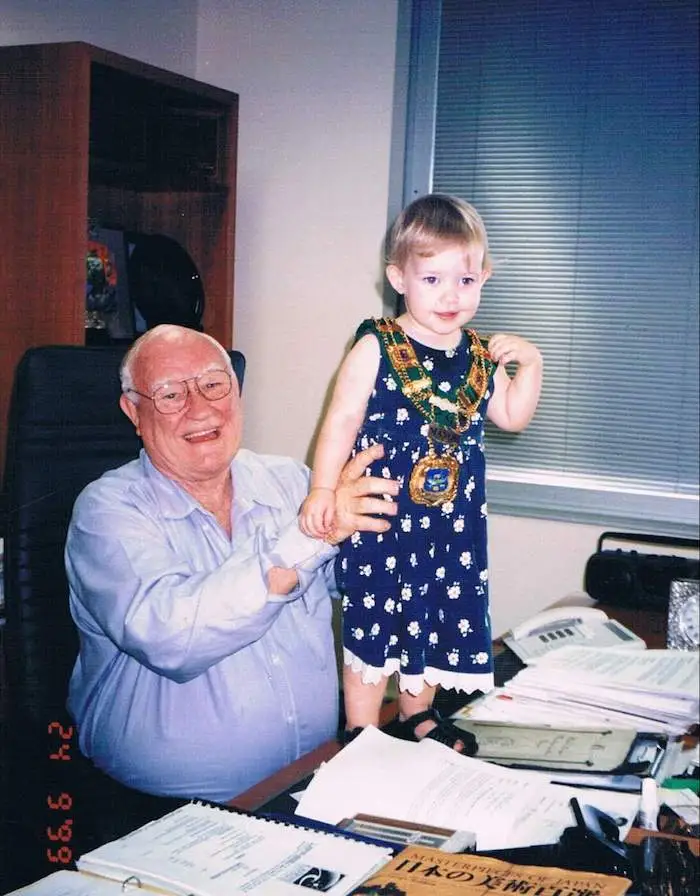
Mount Sheridan
Our part of Mount Sheridan was known as Forest Gardens. The area was absolutely beautiful, as the developer was still investing in the gardens and infrastructure (to sell more houses). It was a joy to travel around the suburb with Kate on my lap. As an unknown author once observed, “A daughter may outgrow your lap, but she will never outgrow your heart.”
As a father, you will never ever relive the joy of having a daughter who is three or four. I still recall traveling around the tropical gardens in Mount Sheridan with Kate sitting on my lap. She would hold onto my shirt with her little hand, so that she wouldn’t fall off the wheelchair if I stopped suddenly. It was an adorable experience that we both enjoyed.

After Caroline’s death, I met a young man named Simon Perry, who became my support worker. He had an interest in folk music and was a card-carrying member of the Industrial Workers of the World (IWW). We had a lot in common.
Simon moved to Cairns from Sydney to get away from drugs and negative factors in his own life. We would often meet at JCU, where he would help me with tasks of a physical nature and help me access my own medication. One day he was helping me at JCU and he met a young Melbournian woman of Australian-Maltese heritage named Liz with whom he would spend the rest of his life. So life seemed to have some synchronicity about it.
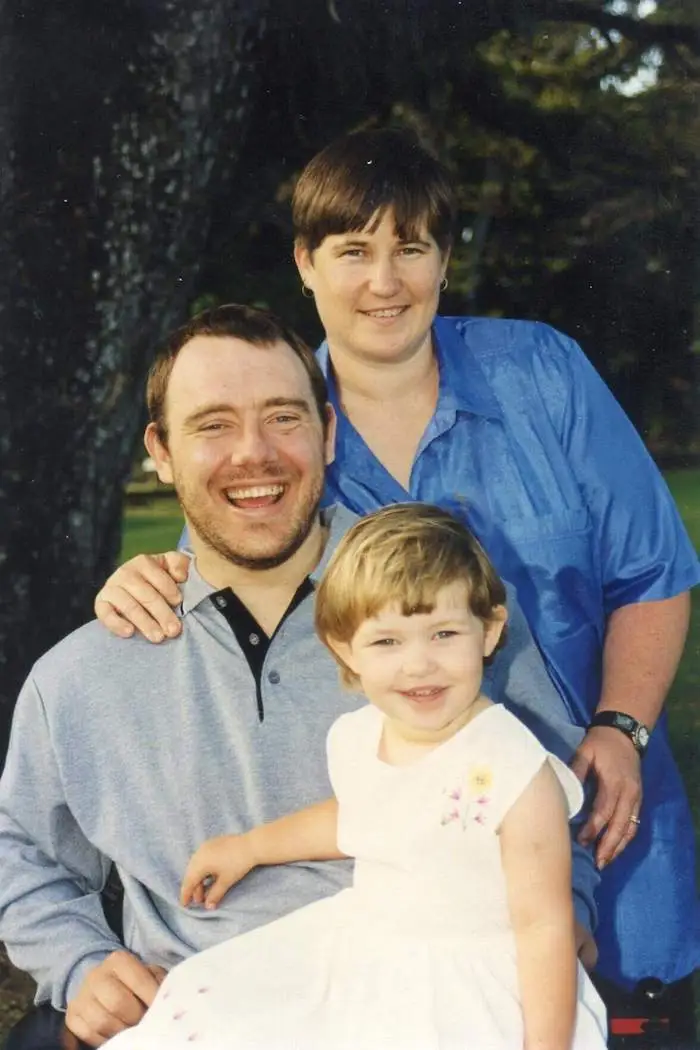
Work for People with Disabilities
Ironically, soon after Jenny and I moved back to the south-side, the RDLO position was re-advertised. I applied again and was granted an interview. This time I was successful!
The Australian Government had established the RDLO position to address the appallingly low transition rate of people with disabilities from school to higher education.
My role was to assist people with disabilities in that transition. I worked to help students with disabilities who had the ability to undertake tertiary study. I took on the challenge with enthusiasm. Working with students one on one and in groups, I encouraged them to consider study at university or TAFE.
Each semester I held an ‘options’ event, inviting a number of students with disabilities from local high schools and hosting them at JCU or TAFE. Students attended a lecture, had lunch in the refectory, learnt about library services, and were individually advised what other support services were available.
These ‘options’ events helped to address the perception by students that higher education was ‘out of reach’. The remedy was exposing them to university or TAFE first-hand. This way, students could see higher education as a realistic prospect.
What I loved about the job was that I had discretion to focus my efforts into areas that I thought appropriate. I spent much of my time breaking down barriers and educating people regarding disability and disability issues. I also worked with JCU staff in creating a wheelchair-friendly campus.
‘People With Disabilities’ School Visits
One part of the job I really enjoyed was visiting primary schools and talking to children about disability. I especially enjoyed visiting children in country schools. It was challenging for me to head out west and into the gulf region, but I found children there to be more open and easier to talk to.
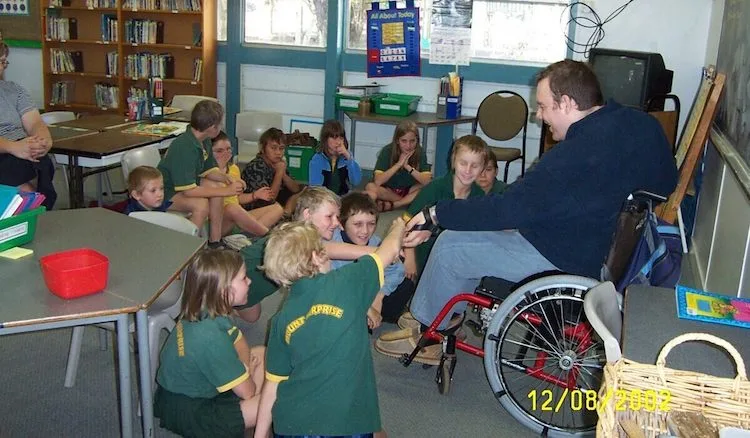
At the end of 2007 an institution in another city won the tender for the RDLO position. So I finished in my role at the end of that year. I collected my long-service pay and other entitlements, and started to plan my own tilt at entering local politics. With Tom Pyne happily retired, I would take my own shot at running for an elected position on Cairns Regional Council in 2008.
All Chapters:
- Far North Queensland
- Growing up in Australia
- Aboriginal and Torres Strait Islander People
- Queensland Political Culture
- Princess Alexandra Hospital Spinal Unit
- People with Disabilities
- Cairns Regional Council
- Conservative Cairns Council
- ALP Qld
- Abortion Law Reform
- Fighting Fossil Fuel
- Local Government Corruption
- Losing to Labor
- My Cairns Council Return
- Council Mayors Silencing Dissent
- Socialist Alliance and Fighting Fascism
- Jenny Pyne, Life and Pain
- Cairns Council Lurches Right
- Fightback and Farewell
